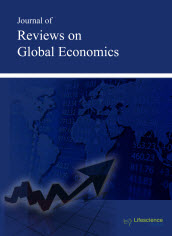Transformation of the Forecast Assessment of Expected Credit Losses in Monitoring and Assessment of Credit Risk in Commercial Banks
DOI:
https://doi.org/10.6000/1929-7092.2020.09.04Keywords:
Assessment of expected credit losses, credit risk, default, bank borrower, financial instruments.Abstract
The article presents the results of the systematization of issues arising in connection with the transformation of the banks forecast assessment of expected credit losses during the monitoring and evaluation of credit risk in commercial banks. Based on the data obtained on the introduction of IFRS 9 "Financial instruments" into the banking sector, it is concluded that in banking practice there is uncertainty regarding the long-term impact of credit risk, and there are significant difficulties with the use of a large amount of additional information, which creates certain difficulties in calculating future credit losses of banks. It is noted that the current use of the model of predictive assessment of expected credit losses of customers in the monitoring and evaluation of credit risk in the bank should take into account the selected collective or individual basis of assessment. The article presents a comprehensive approach to the use of the impairment model of expected losses in banking as a basic tool for modeling expected credit losses in order to form provisions for impairment with the allocation. The modification of this model will depend on the specifics of the bank's credit activities and portfolio, the types of its financial instruments, the sources of available information, as well as the IT systems used. Validation of this model will reduce the expected credit losses, reduce the amount of estimated reserves, as well as improve the efficiency of the Bank as a whole.
References
Caroline Roulet Basel III: Effects of capital and liquidity regulations on European bank lending, Journal of Economics and Business, Volume 95, January–February 2018, Pages 26-46
https://doi.org/10.1016/j.jeconbus.2017.10.001
Chunping Liu, Patrick Minford How important is the credit channel? Journal of Banking & Finance, Volume 41, April 2014, Pages 119-134
https://doi.org/10.1016/j.jbankfin.2013.12.017
Cipullo Nadia, Vinciguerra Rosa The Impact of IFRS 9 and IFRS 7 on Liquidity in Banks: Theoretical Aspects, Procedia - Social and Behavioral Sciences, Volume 164, 31 December 2014, Pages 91-97.
https://doi.org/10.1016/j.sbspro.2014.11.055
Cuiqing Jiang, Zhao Wang, Huimin Zhao, A prediction-driven mixture cure model and its application in credit scoring, European Journal of Operational Research, Volume 277, Issue 1, 16 August 2019, Pages 20-31.
https://doi.org/10.1016/j.ejor.2019.01.072
Dell’Ariccia G. Asymmetric Information and the Structure of the Banking Industry. European Economic Review. – 2001. – Vol. 45(10). – Pages 1957–1980.
Demirgüç-Kunt A., Feyen E., Levine R. The Evolving Importance of Banks and Securities Markets. World Bank Economic Review. – 2013. – Vol. 27(3). – Pages 476–490.
Demyanyk, Y. and Hasan, I. (2010). Financial crises and bank failures: a review of prediction methods. Omega, 38(5), Pages 315–324.
Domac I., Martinez-Peria M.S. Banking Crises and Exchange Rate Regimes: is Tere a Link? Journal of International Economics. – 2003. – Vol. 61. – Pages 41–72.
Fan Liu, Zhongsheng Hua, Andrew Lim, Identifying future defaulters: A hierarchical Bayesian method, European Journal of Operational Research, Volume 241, Issue 1, 2015, Pages 202-211.
https://doi.org/10.1016/j.ejor.2014.08.008
Kaminsky G., Reinhart C., The Twin Crises: The Causes of Banking and Balance-of-Payments Problems. American Economic Review. – 1999. – Vol. 89(3). – Pages 473–500.
Kjartan Kloster Osmundsen, Using expected shortfall for credit risk regulation, Journal of International Financial Markets, Institutions and Money, Volume 57, November 2018, Pages 80-93.
https://doi.org/10.1016/j.intfin.2018.07.001
Landini S., Uberti M., Casellina S., Credit risk migration rates modelling as open systems II: A simulation model and IFRS9-baseline principles, Structural Change and Economic Dynamics, Volume 50, September 2019, Pages 175-189.
https://doi.org/10.1016/j.strueco.2019.06.013
Mayes, D. and Stremmel, H. (2014). The effectiveness of capital adequacy measures in predicting bank distress. SUERF Studies, 1. Vienna, Pages 1-54.
Nandana P. W. Pathiranage, Christine A. Jubb, Does IFRS make analysts more efficient in using fundamental information included in financial statements? Journal of Contemporary Accounting & Economics, Volume 53, Issue 2, Pages 77-101.
https://doi.org/10.1016/j.jcae.2018.10.004
Rajan R.G. Has Financial Development Made the World Riskier? Proceedings - Economic Policy Symposium. – Jackson Hole Issue. – 2005. Pages 313-369.
Schularick M., Taylor A. Credit Booms Gone Bust: Monetary Policy, Leverage Cycles, and Financial Crises, 1870–2008. American Economic Review. – 2012. – Vol. 102. – Pages 1029–1061.
Schumpeter J.A. A Theory of Economic Development – Cambridge, MA: Harvard University Press. – 1911.
Sriya Anbil, Alessio Saretto, Heather Tookes How does hedge designation impact the market’s perception of credit risk? Journal of Financial Stability, Volume 41, April 2019, Pages 25-42.
https://doi.org/10.1016/j.jfs.2019.01.001
Yuta Tanoue, Akihiro Kawada, Satoshi Yamashita, Forecasting loss given default of bank loans with multi-stage model, International Journal of Forecasting, Volume 33, Issue 2, April–June 2017, Pages 513-522.
https://doi.org/10.1016/j.ijforecast.2016.11.005
Ernst & Young Global Limited (EY), Research questions impairment according to IFRS (IFRS) 9, the characteristic for banking sector https://www.ey.com/Publication/vwLUAssets/ey-ifrs-9-impairment-banking-survey-2018-ru/$FILE/ey-ifrs-9-impairment-banking-survey-2018-ru.pdf
Downloads
Published
How to Cite
Issue
Section
License
Policy for Journals/Articles with Open Access
Authors who publish with this journal agree to the following terms:
- Authors retain copyright and grant the journal right of first publication with the work simultaneously licensed under a Creative Commons Attribution License that allows others to share the work with an acknowledgement of the work's authorship and initial publication in this journal.
- Authors are permitted and encouraged to post links to their work online (e.g., in institutional repositories or on their website) prior to and during the submission process, as it can lead to productive exchanges, as well as earlier and greater citation of published work
Policy for Journals / Manuscript with Paid Access
Authors who publish with this journal agree to the following terms:
- Publisher retain copyright .
- Authors are permitted and encouraged to post links to their work online (e.g., in institutional repositories or on their website) prior to and during the submission process, as it can lead to productive exchanges, as well as earlier and greater citation of published work .






